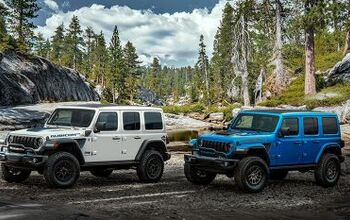PSA to GM: Pay Up for That Dirty Fleet You Sold Us

The handover of General Motors’ money-losing European division to France’s PSA Group seemed complete last July, but now the maker of Peugeot and Citroen cars isn’t happy with the bag it’s holding.
PSA claims the acquisition of the Opel and Vauxhall brands left it on the hook for massive fines, all stemming from looming European emissions regulations and the not-so-squeaky-clean state of its new holdings. The automaker’s now seeking nearly $1 billion from GM — more than half of what it paid for the brands.
Ultra-strict European Union emissions regulations slated to come into effect in 2021 would penalize PSA for its newly acquired fleet, something that apparently wasn’t known at the time of the handover. According to a Reuters report, PSA says the scale of the problem only became clear after it took ownership. Blame a brand with one gee-whiz clean car and a full stable of emissions laggards.
“We became aware a few weeks after we finalised the closing that the company was going to the wall on CO2 emissions,” PSA Group CEO Carlos Tavares told reporters in early November. “If you fail to comply (with EU rules) the weight of fines you are hit with can threaten the company’s existence.”
Tavares said his company immediately set about accelerating product development. The move to switch Opel and Vauxhall products to PSA platforms (with cleaner French engines) was pushed ahead three years. Still, the new breed won’t appear until 2024.
Sources close to the issue tell Reuters that GM underestimated the public’s switch away from diesel-powered cars in its calculations. It also relied heavily on sales of the all-electric Opel Ampera-e (Chevrolet Bolt) to meet its emissions targets. The looming regulation change punishes each car in an automaker’s fleet for every extra gram of carbon dioxide it spews per kilometer, to the tune of $113 per vehicle. A crushing load of fines wouldn’t take long to pile up.
“People who had worked on the closing realised quite quickly that there were these big discrepancies,” one PSA source said. “They had been swept under the rug.”
Another source said that PSA stood to lose over $11,000 for each Ampera-e sold, making the company’s reliance on that one car doubly risky.
“Their technical solution was economically unviable and would have led to enormous losses,” the source told Reuters. “So the first thing you do is drop that (product) line, but then the fleet emissions explode.”
Besides expediting the development of new vehicles, PSA was forced to slap together hybrid variants of several Opel cars. This wasn’t part of the original product plan. Still, the state of Opel’s fleet wasn’t entirely a secret leading up to the sale.
“We’ve been reporting for years that Opel/Vauxhall would have significant problems meeting the CO2 targets as GM brands in Europe,” said Thomas Goettle, head analyst at PA Consulting. The firm published a study detailing Opel and the 2021 emissions regulations in November 2016. “Opel is five to seven years behind with their engine lineup,” he added.
GM spokesman David Caldwell wouldn’t comment on whether the two companies discussed emissions, only stating, “We provided them with substantial information.”
PSA has not yet filed any legal claims against GM.
[Image: General Motors]

More by Steph Willems
Latest Car Reviews
Read moreLatest Product Reviews
Read moreRecent Comments
- MaintenanceCosts "And with ANY car, always budget for maintenance."The question is whether you have to budget a thousand bucks (or euro) a year, or a quarter of your income.
- FreedMike The NASCAR race was a dandy. That finish…
- EBFlex It’s ironic that the typical low IQ big government simps are all over this yet we’re completely silent when oil companies took massive losses during Covid. Funny how that’s fine but profits aren’t. These people have no idea how business works.
- Ajla Goldman Sachs 🥂
- Rna65689660 DVR and watch all that are aired. Has been this way for 40 years.


































Comments
Join the conversation
I don't have a dog in this fight, but it will provide some good entertainment going forward. I wonder if any of the parties involved will learn anything constructive this time?
So basically PSA is claiming they're Packard and Opel/Vauxhall is Studebaker?